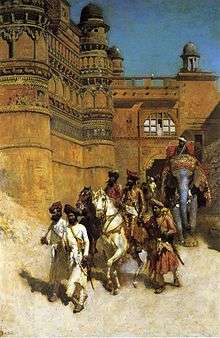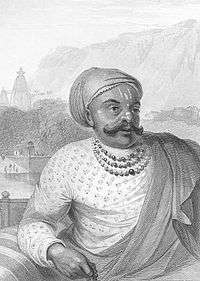Shinde
Shinde (Marathi: शिंदे) is a clan and surname among the Prominent Royal Families of 96 kuli maratha (Maharashtrian) people of India. Variations of the name include Scindia, Scindhia, Sindhia, Sindia, Sindhe and Shinday.
| Maratha Clan Shinde/Scindia | |
| Surname | Shinde/Scindia(alternately Shinde,Sendrak) |
| Caste | Maratha Kshatriya |
| Religion: | Hinduism |
| Original kingdom | Ranathambore and Pattadakal |
| Other kingdoms | Gwalior, Ujjain, Badami. |
| Capitals | Satara Villages. Chiplun Villages |
| Lineage | Claimed Suryavansha or Sheshvanshi |
| Nishan | Serpent on flagpole. |
| Clan god | Jyotiba ( Mahadev ). |
| Clan goddess | Tulja Bhavani (Tuljapur,Maharashtra) Kalika, Ramvardayini Devi |
| Guru | Kaundinya |
| Colour | Red. |
| Veda | Rigveda. |
| Gotra | Kaundinya |
| Mantra | Yajurveda - Madhyandin, Gayatri Mantra.. |
| Prawar | Angiras, Brihaspati and Kaundinya. |
| Victory Weapon | Sword |
| Guhyasutra | Paraska |
| Locations | Maharashtra, Karnataka, Madhya Pradesh, Andhra Pradesh, Gujarat and Goa |
| Languages | Marathi, Kannada, Sanskrit. |
The Scindia/Shinde dynasty was founded by Maharaja Ranoji Rao Scindia, who was the son of Maharaja Jankoji Rao Scindia, the Deshmukh of Kanherkhed, a village in Satara District, Maharashtra.
History

The Scindia dynasty was founded by Ranoji Scindia, who was the son of Jankojirao Scindia, the Deshmukh of Kanherkhed, a village in Satara District, Maharashtra.Scindia's ancestors were originally of the Kunbi community. The British records proves that Ranoji Scindia was of Kunbi Caste. Peshwa Baji Rao's career saw the strengthening of the Maratha Empire. Ranoji was in charge of the Maratha conquests in Malwa in 1726. Ranoji established his capital at Ujjain in 1731. His successors included Jayajirao, Jyotibarao, Dattajirao, Jankojirao, Mahadji Shinde and Daulatrao Scindia. The Scindhia state of Gwalior became a major regional power in the latter half of the 18th century and figured prominently in the three Anglo-Maratha Wars. They held sway over many of the Rajput states, and conquered north India.
After the defeat of the allied Maratha states by the British in the Third Anglo-Maratha War of 1818, Daulatrao Scindia was forced to accept local autonomy as a princely state within British India and to give up Ajmer to the British. After the death of Daulatrao, Maharani Baiza Bai ruled the empire, saving it from the British power, till the adopted child Jankoji Rao took over the charge. Jankoji died in 1843, and his widow Tarabai Raje scindia successfully maintained the position and adopted a child from close lineage named Jayajirao.
The Scindia family ruled Gwalior until India's independence from the United Kingdom in 1947, when the Maharaja Jivajirao scindia acceded to the Government of India. Gwalior was merged with a number of other princely states to become the new Indian state of Madhya Bharat. George Jivajirao served as the state's rajpramukh, or appointed governor, from 28 May 1948 to 31 October 1956, when Madhya Bharat was merged into Madhya Pradesh.
The Shindes, who served as the chiefs of Soundatti in the twelfth century settled down in Jamkhandi as soldiers and agriculturists became vegetarians with the influence of Lingayats and Madhwa Brahmins and spoke Kannada. The Shinde families who migrated to Kannada State completely adapted themselves to the Kannada ways.[1]
In 1962, Rajmata Vijayraje Scindia, the widow of Maharaja Jiwajirao, was elected to the Lok Sabha, beginning the family's career in electoral politics. She was first a member of the Congress Party, and later became an influential member of the Bharatiya Janata Party. Her son Madhavrao Scindia was elected to the Lok Sabha in 1971 representing the Congress Party, and served until his death in 2001. His son, Jyotiraditya Scindia, also in the Congress Party, was elected to the seat formerly held by his father in 2004.
Vijayaraje's daughters have supported the Bharatiya Janata Party. Vasundhara Raje Scindia contested and won five parliamentary elections from Madhya Pradesh and Rajasthan. Under the Vajpayee government from 1998 onwards, Vasundhara was in charge of several different ministries. In 2003 she led the Bharatiya Janata Party to its largest majority in Rajasthan, and became the state's Chief Minister. In 2013 again, she led Bharatiya Janata Party to a thumpin win in the state of Rajasthan, winning over 160 out of the 200 seats in the assembly elections. Her other daughter, Yashodhara Raje Scindia, contested assembly elections from Shivpuri in Madhya Pradesh and won in 1998, 2003 and 2013 and also lokshabha 2004,2009 from gwalior. Upon the BJP's win in the state, she became the state's Minister for Tourism, Sports and Youth Affairs. Vasundhara's son Dushyant Singh entered the Lok Sabha in 2004 from Rajasthan.
Origins
_as_seen_in_the_Illustrated_London_News.gif)
The Scindia served the Peshwa(Prime minister of Chhtrapati Maharaj of Satara), and were also Shiledars under the sultanates of the Deccan.[2]
Scindia Maharajas of Ujjain and Gwalior
- Ranoji Rao Scindia (1731 – 19 July 1745). Died 19 July 1745.
- Jayappa Rao Scindia (1745 – 25 July 1755). Born c 1720, died 25 July 1755.
- Jankoji Rao Scindia I (25 July 1755 – 15 January 1761). Born 1745. died 15 January 1761.
- Dattaji Rao Scindia (Regent 1755 – 10 January 1760). Died 10 January 1760.
- Vacant 15 January 1761 – 25 November 1763
- Kadarji Rao Scindia (25 November 1763 – 10 July 1764) Died ?.
- Manaji Rao Scindia (10 July 1764 – 18 January 1768) Died ?.
- Mahadaji Shinde (18 January 1768 – 12 February 1794). Born c.1730, died 12 February 1794.
- Daulat Rao Scindia (12 February 1794 – 21 March 1827). Born 1779, died 21 March 1827.
- Jankoji Rao Scindia II (18 June 1827 – 7 February 1843). Born 1805, died 7 February 1843.
- Jayaji Rao Scindia (7 February 1843 – 20 June 1886). Born 19 January 1835, died 20 June 1886.
- Madho Rao Scindia (20 June 1886 – 5 June 1925). Born 20 October 1876, died 5 June 1925.
- George Jivaji Rao Scindia (Maharaja 5 June 1925 – 15 August 1947, Rajpramukh 28 May 1948 – 31 October 1956, later Rajpramukh) Born 26 June 1916, died 16 July 1961.
- Madhav Rao Scindia (Born 10 March 1945, died 30 September 2001)
- Jyotiraditya Madhavrao Scindia (born 1 January 1971)
Other people with this name
- Sadashiv Shinde, Indian cricketer
- Sayaji Shinde, Indian actor
- Tarabai Shinde, Indian feminist
- Gauri Shinde, Film Director
- Jyotiraditya Scindia, Indian Politician
- Vasundhara Raje Scindia, Indian Politician
- Shilpa Shinde, TV actress
References
- The Era of Scindia dynasty at strengthening of the Maratha Empire.
- Lokrajya, Volume 30. Directorate-General of Information and Public Relations. 1974. p. 5.
The Shindes, who were the chiefs of Soudatti in the twelfth century, had come to settle in Jamkhandi as soldiers and agriculturists. Under the influence of the Lingayats and the Madhva Brahmins, they had given up meat-eating and they also spoke Kannada in the accents of the Deshastha Brahmins. Their names too followed the Kannada patterns, etc., Basvanna (grandfather), Vyankappa (uncle), Janakka (Sister) and the like.
- Richard M. Eaton (19 December 2005). A social history of the Deccan, 1300-1761: eight Indian lives. Cambridge University Press. pp. 188–. ISBN 978-0-521-25484-7. Retrieved 16 July 2011.
